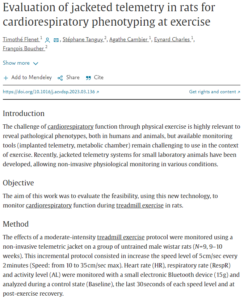Evaluation of jacketed telemetry in rats for cardiorespiratory phenotyping at exercise
T. Flenet1 ; S. Tanguy2 ; A. Cambier1,2 ; E. Charles1 ; F. Boucher2
¹ Biomedical engineering, ETISENSE SAS, Lyon, France;
² CNRS, timc-imag umr 5525, Université Grenoble Alpes, Saint-Martin-d’Hères, France
18ème édition du Printemps de la Cardiologie, 2023
https://doi.org/10.1016/j.acvdsp.2023.03.136
Abstract
Introduction: The challenge of cardiorespiratory function through physical exercise is highly relevant to reveal pathological phenotypes, both in humans and animals, but available monitoring tools (implanted telemetry, metabolic chamber) remain challenging to use in the context of exercise. Recently, jacketed telemetry systems for small laboratory animals have been developed, allowing non-invasive physiological monitoring in various conditions.
Objective: The aim of this work was to evaluate the feasibility, using this new technology, to monitor cardiorespiratory function during treadmill exercise in rats.
Method: The effects of a moderate-intensity treadmill exercise protocol were monitored using a non-invasive telemetric jacket on a group of untrained male wistar rats (N = 9, 9–10 weeks). This incremental protocol consisted in increase the speed level of 5 cm/sec every 2 minutes (Speed: from 10 to 35 cm/sec max). Heart rate (HR), respiratory rate (RespR) and activity level (AL) were monitored with a small electronic Bluetooth device (15 g) and analyzed during a control state (Baseline), the last 30 seconds of each speed level and at post-exercise recovery.
Results: The animals were equipped with the device and placed back in their home cage. After 25 minutes of stabilization, HR was 392 ± 36 bpm, RespR was 173 ± 53 brpm, and AL was 15 ± 12 mg. All animals successfully ran on the treadmill with the jacket to the maximum speed of 35 cm/sec. Exercise induced a significant physiological increase in HR (+26%, 104 ± 21 bpm, P < 0.01) and RespR (+73%, 126 ± 22 brpm, P < 0.01).
Conclusion: In conclusion, this novel telemetry jacket can be used to monitor cardiorespiratory parameters adaptation during a standard forced exercise protocol. Jacketed telemetry provides a completely non-invasive way to study the phenotypes of animals avoiding any additional risk on fragile pathological models and meeting the regulatory 3Rs requirements. As illustrated phenotype characterization can be enriched with a monitoring of the animal in various situations (treadmill, home cage, but also metabolic or hypoxia cage, etc.…).

